The Golden Age in the Golden State












Peter Paul Rubens (Flemish, 1577–1640)
Saint Catherine, ca. 1620
Etching
The Huntington Library, Art Collections, and Botanical Gardens, Edward W. and Julia B. Bodman Collection; 72.62.422
Signed by the artist, this work is often thought to be the only print that the artist himself created. The beautiful saint is shown with her attributes, including a broken wheel, an instrument of the torture she suffered for fighting the persecution of Christians. Rubens's dramatic worm's-eye view emphasizes her grandeur and courage, further accentuated by the spirited tilt of her head and muscular left leg extending toward the viewer.
Rembrandt van Rijn (Dutch, 1606–1669)
Jesus Healing the Sick (The Hundred Guilder Print), ca. 1649
Etching
The Huntington Library, Art Collections, and Botanical Gardens, Edward W. and Julia B. Bodman Collection; 72.62.384
Jesus seems to be the source of light in the center of this monumental print, called the Hundred Guilder Print for the high price it commanded in seventeenth-century Holland. Rembrandt has masterfully combined into one composition various scenes from the nineteenth chapter of Matthew, which tells of Christ healing the sick. The wide tonal range and myriad expressions help render the various dramas taking place, from debating scholars on the left to a camel and dozing traveler on the right.
Hendrick Goltzius (Dutch, 1558–1617)
Lamentation of the Virgin, 1596
Engraving
The Huntington Library, Art Collections, and Botanical Gardens, Edward W. and Julia B. Bodman Collection; 72.62.227
Goltzius, the leading Dutch engraver of his day, was especially famed for his sophisticated technique. In this moving image of the Virgin mourning the loss of her son, the artist creates masterful tonal effects with thicker and thinner lines and fine cross-hatching, particularly in the modeling of Christ's torso and the Virgin's drapery on the ground
Rembrandt van Rijn (Dutch, 1606–1669)
Death of the Virgin, 1639
Etching and drypoint, state ii/v
Crocker Art Museum, gift of Kelvin and Merle Neil; 2007.80
Rembrandt took full advantage of copper's softness, modifying his plates by burnishing out figures or adding new elements in drypoint. He also varied his images by inking plates in specific ways. The mourners at Mary's bedside, from the Jewish priest and acolyte at left to the men entering at right, add drama through variety of expression and pose. Above the bed, the artist explores the supernatural, its silvery quality achieved by careful inking. The English portraitist-collector Thomas Lawrence owned this print.
Jan Savery (Dutch, 1589–1654)
Elephant and Monkey
Black chalk and brownish wash
Crocker Art Museum, E. B. Crocker Collection; 1871.101
Jan Savery studied with his famous uncle, Roelandt Savery, and soon became a painter in his own right. Jan's drawing of a nit-picking monkey on the back of an elephant may be based on animals in contemporary prints, though merchant ships often brought such exotic creatures to the Netherlands. The elephant appears twice more in the background, surrounded by graceful date palms and intricate shells. The elephant's patient expression in response to the monkey's antics adds a note of humor to the scene.
Marten de Cock (Flemish, ca. 1576–ca. 1661)
Riverside Landscape, 1636
Pen and brown ink, black chalk on parchment
Crocker Art Museum, E. B. Crocker Collection; 1871.547
In this meticulous pen–and-ink drawing, the landscapist Marten de Cock incorporates elements from a long tradition of riverside scenes. Along a cliff-side landing, shallow skiffs bring people and goods to shore while merchants, one on horseback, look on. At the tavern on the right, men gather to gamble away their earnings. The tiny scale of this rugged landscape and its execution on parchment recall illuminated manuscripts.

Past eventSat., Dec. 5, 2009, 12 a.m.–11:59 p.m.
Huntington Art Gallery, Works on Paper Room
During the nineteenth century, art of the Dutch Golden Age—roughly the seventeenth century—was the most sought by American collectors. Wealthy New Yorkers and Philadelphians vied for paintings, drawings and prints in the dealers' rooms and auction houses of Europe. A few pioneering Californians, far from looking on, joined the fray. This exhibition, drawn from the Huntington Library and the Crocker Art Museum, founded by early California patrons, includes objects that entered California by 1871. They form part of the state's earliest artistic legacy.
Golden Age art was especially appropriate for American collectors, who identified strongly with the prosperous merchants behind the great flowering of art in the seventeenth-century Netherlands. Against a background of eighty years of war, trade with the East and the New World flourished. The struggles of the Protestant North against the domination of Spain gained the new country independence in 1648, creating the stability that led to further growth in art and its market. In the Catholic South, the reaffirmation of Church and aristocracy as social forces also took artistic form, with altarpieces, portraits, and history paintings commissioned from a large community of artists. Printmakers, already important because of book publishing, created some of the most innovative and brilliant images in the history of art. This selection of prints and drawings shows many sides of the Golden Age, from religious works by Rubens and Rembrandt to landscapes and political satire.
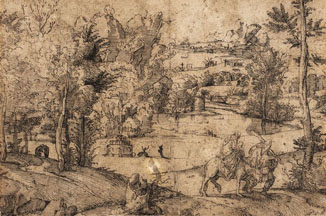 Jan Wellens de Cock (Flemish, ca. 1480–1527) or the monogrammist PC (Dutch, flourished 1524–1541)
Jan Wellens de Cock (Flemish, ca. 1480–1527) or the monogrammist PC (Dutch, flourished 1524–1541)
Flight into Egypt
Black ink on beige laid paper
Crocker Art Museum, E. B. Crocker Collection; 1871.98
This drawing, created at a time when landscape was becoming an independent genre, is centered on a winding river with paths, trees, and cliffs. A distant village draws the viewer’s gaze toward the horizon. The details of the landscape and passersby may obscure the religious subject, Mary and Joseph’s journey into Egypt with the newborn Christ to escape Herod’s armies. The Holy Family, at right, swathed in traveling cloaks, is identified only by Mary’s halo.
 Denys Calvaert (Flemish, 1540–1619)
Denys Calvaert (Flemish, 1540–1619)
Last Supper, 1600
Pen and black ink, brush and brown wash, and white opaque watercolor
Crocker Art Museum, E. B. Crocker Collection; 1871.110
Trained first in Antwerp, Denys Calvaert went to Italy early in his career, settling in Bologna. He immersed himself in the work of earlier Italian painters, and attracted the attention of the Bolognini family, who became his patrons. Famous seventeenth-century artists such as Guido Reni and Domenichino apprenticed in his studio. This Last Supper, with its balanced composition, naturalistic modeling of the human figure, and classically inspired architecture, shows how thoroughly Italian the mature Calvaert had become.
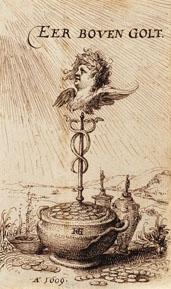 Hendrick Goltzius (Dutch, 1558–1617)
Hendrick Goltzius (Dutch, 1558–1617)
Honor above Gold, 1609
Pen and dark brown ink
Crocker Art Museum, E. B. Crocker Collection; 1871.143
During the sixteenth century the emblem, which combined image and text to elucidate a moral point, became a popular form of visual language. Audiences delighted in decoding the meanings of emblems, and their popularity influenced personal devices like this one. A brilliant and versatile engraver and painter, Goltzius matched technical virtuosity with an inquisitive mind. Here a laurel-crowned spirit representing honor floats above a pot of gold coins and vessels made of precious metal. The motto above incorporates a pun on Goltzius’s name.
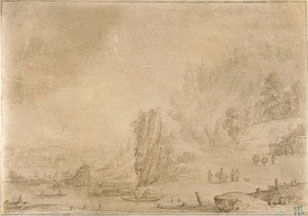 Marten de Cock (Flemish, ca. 1576–ca. 1661)
Marten de Cock (Flemish, ca. 1576–ca. 1661)
Riverside Landscape, 1636
Pen and brown ink, black chalk on parchment
Crocker Art Museum, E. B. Crocker Collection; 1871.547
In this meticulous pen–and-ink drawing, the landscapist Marten de Cock incorporates elements from a long tradition of riverside scenes. Along a cliff-side landing, shallow skiffs bring people and goods to shore while merchants, one on horseback, look on. At the tavern on the right, men gather to gamble away their earnings. The tiny scale of this rugged landscape and its execution on parchment recall illuminated manuscripts.
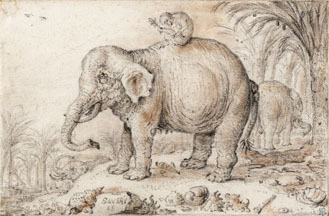 Jan Savery (Dutch, 1589–1654)
Jan Savery (Dutch, 1589–1654)
Elephant and Monkey
Black chalk and brownish wash
Crocker Art Museum, E. B. Crocker Collection; 1871.101
Jan Savery studied with his famous uncle, Roelandt Savery, and soon became a painter in his own right. Jan's drawing of a nit-picking monkey on the back of an elephant may be based on animals in contemporary prints, though merchant ships often brought such exotic creatures to the Netherlands. The elephant appears twice more in the background, surrounded by graceful date palms and intricate shells. The elephant’s patient expression in response to the monkey’s antics adds a note of humor to the scene.
 Simon de Vlieger (Dutch, ca. 1601–1653)
Simon de Vlieger (Dutch, ca. 1601–1653)
Tree
Charcoal, brush and gray washes, black chalk
Crocker Art Museum, E. B. Crocker Collection; 1871.594
Though most of his surviving drawings are landscapes, Simon de Vlieger made his name as a painter of marine scenes. This particularized drawing, almost a portrait, of an oak tree shows the wide variety of effects the artist achieved by exploiting different media. The rich blacks of charcoal show through the grays applied with the brush, and the leafy highlights of paper left white are outlined with the point of black chalk.
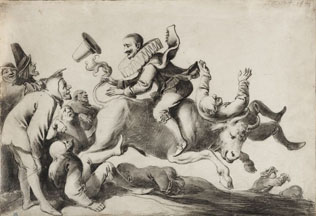 Pieter Quast (Dutch, ca. 1606–1647)
Pieter Quast (Dutch, ca. 1606–1647)
Allegory of the Spanish Withdrawal from the Netherlands, 1641
Black chalk, graphite, brush and gray wash on parchment
Crocker Art Museum, E. B. Crocker Collection; 1871.578
The waning of the Eighty Years’ War proved ripe for satirists, as Dutch Protestants met with increasing success against their Spanish occupiers. Pieter Quast, a keen observer of humanity and its foibles, created political drawings to supplement his biting satires of peasant and military life. Here a bull, symbolizing the Netherlands, bucks and snorts as it tries to cast off the terrified Spaniard riding backward in his knee breeches and ruff. Bystanders jeer as the Spaniard’s hat goes flying, while others flee the bull’s pointed horns.
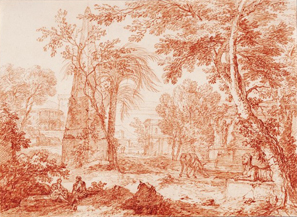 Jan van Huysum (Dutch, 1682–1749)
Jan van Huysum (Dutch, 1682–1749)
Rest on the Flight into Egypt
Red chalk
Crocker Art Museum, E. B. Crocker Collection; 1871.206
Jan van Huysum’s classicizing landscapes commanded extremely high prices during his lifetime. He is best known now for delicate and exacting flower paintings, done with the collaboration of Haarlem bulb growers. Here, as in the sixteenth-century drawing of the Flight into Egypt elsewhere in this exhibition, the religious subject is subsumed into an exotic landscape. Sphinxes and obelisks, classicizing buildings, and even the donkey’s fountain add visual interest to the grove of trees, including a wispy-leaved palm.
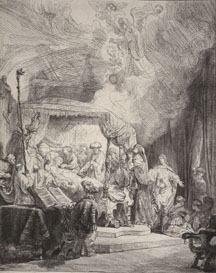 Rembrandt van Rijn (Dutch, 1606–1669)
Rembrandt van Rijn (Dutch, 1606–1669)
Death of the Virgin, 1639
Etching and drypoint, state ii/v
Crocker Art Museum, gift of Kelvin and Merle Neil; 2007.80
Rembrandt took full advantage of copper’s softness, modifying his plates by burnishing out figures or adding new elements in drypoint. He also varied his images by inking plates in specific ways. The mourners at Mary’s bedside, from the Jewish priest and acolyte at left to the men entering at right, add drama through variety of expression and pose. Above the bed, the artist explores the supernatural, its silvery quality achieved by careful inking. The English portraitist-collector Thomas Lawrence owned this print.
Pieter van der Heyden (Flemish, 1530–1575) after Pieter Bruegel the Elder (Flemish, 1529–1569)
Desidia (Sloth), 1558
Engraving
The Huntington Library, Art Collections, and Botanical Gardens; 95.17.1
This print, one of seven entitled The Vices, illustrates the perils of laziness. The sleeping Desidia, or Lady Sloth, reclines in the center while various demonic creatures harass the human figures indulging in sloth throughout the scene. The inscription reads, “Sluggishness breaks strength, long idleness [breaks] the nerves. Sloth makes [man] powerless and dries out the nerves until man is good for nothing.”
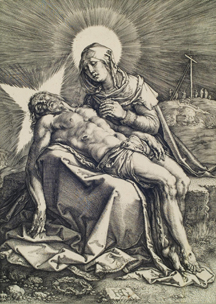 Hendrick Goltzius (Dutch, 1558–1617)
Hendrick Goltzius (Dutch, 1558–1617)
Lamentation of the Virgin, 1596
Engraving
The Huntington Library, Art Collections, and Botanical Gardens, Edward W. and Julia B. Bodman Collection; 72.62.227
Goltzius, the leading Dutch engraver of his day, was especially famed for his sophisticated technique. In this moving image of the Virgin mourning the loss of her son, the artist creates masterful tonal effects with thicker and thinner lines and fine cross-hatching, particularly in the modeling of Christ’s torso and the Virgin’s drapery on the ground
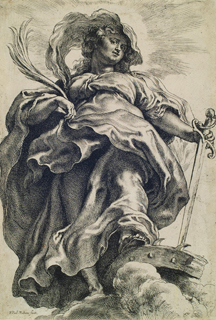 Peter Paul Rubens (Flemish, 1577–1640)
Peter Paul Rubens (Flemish, 1577–1640)
Saint Catherine, ca. 1620
Etching
The Huntington Library, Art Collections, and Botanical Gardens, Edward W. and Julia B. Bodman Collection; 72.62.422
Signed by the artist, this work is often thought to be the only print that the artist himself created. The beautiful saint is shown with her attributes, including a broken wheel, an instrument of the torture she suffered for fighting the persecution of Christians. Rubens’s dramatic worm’s-eye view emphasizes her grandeur and courage, further accentuated by the spirited tilt of her head and muscular left leg extending toward the viewer.
Rembrandt van Rijn (Dutch, 1606–1669)
Self-Portrait with Furrowed Brow, 1630
Etching
The Huntington Library, Art Collections, and Botanical Gardens, gift of Mrs. Homer D. Crotty; 91.284.151
Rembrandt depicts himself overcome with a sudden bout of anger in one of his many studies of extreme facial expressions. His sharply turned head, pursed lips, furrowed brow, and direct gaze at the viewer accentuate the intensity of the moment. The power of this small image is further heightened by the contrast of dark areas—his shaded face, disheveled hair, and thick fur coat—against the untouched ground.
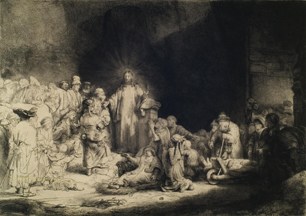 Rembrandt van Rijn (Dutch, 1606–1669)
Rembrandt van Rijn (Dutch, 1606–1669)
Jesus Healing the Sick (The Hundred Guilder Print), ca. 1649
Etching
The Huntington Library, Art Collections, and Botanical Gardens, Edward W. and Julia B. Bodman Collection; 72.62.384
Jesus seems to be the source of light in the center of this monumental print, called the Hundred Guilder Print for the high price it commanded in seventeenth-century Holland. Rembrandt has masterfully combined into one composition various scenes from the nineteenth chapter of Matthew, which tells of Christ healing the sick. The wide tonal range and myriad expressions help render the various dramas taking place, from debating scholars on the left to a camel and dozing traveler on the right.
Rembrandt van Rijn (Dutch, 1606–1669)
Christ Crucified between the Two Thieves: The Three Crosses, 1653
Drypoint and burin
The Huntington Library, Art Collections, and Botanical Gardens, Edward W. and Julia B. Bodman Collection; 72.62.408
In one of the artist’s most dramatic compositions in any medium, he uses his innovative technique to create a print with remarkably expressive and painterly qualities. The drama of the scene—in which Christ suffered most before death on the Cross—is rendered by great shafts of light that tear through the darkness. The tragedy plays out in various ways among the crowd: on the right, the Virgin Mary collapses and John holds his head between clenched fists while, on the left, the crowd looks on in shock
Cornelis Visscher (Dutch, 1586–1658)
The Large Cat, 1657
Engraving
The Huntington Library, Art Collections, and Botanical Gardens; 82.14
The subject of this print, virtually a portrait of the animal, exhibits the artist’s tour-de-force talent in capturing various textures, particularly the sleeping feline’s soft flesh and glossy, luxuriant fur. An audacious mouse adds minor excitement, sneaking out from behind the protection of the window bars.